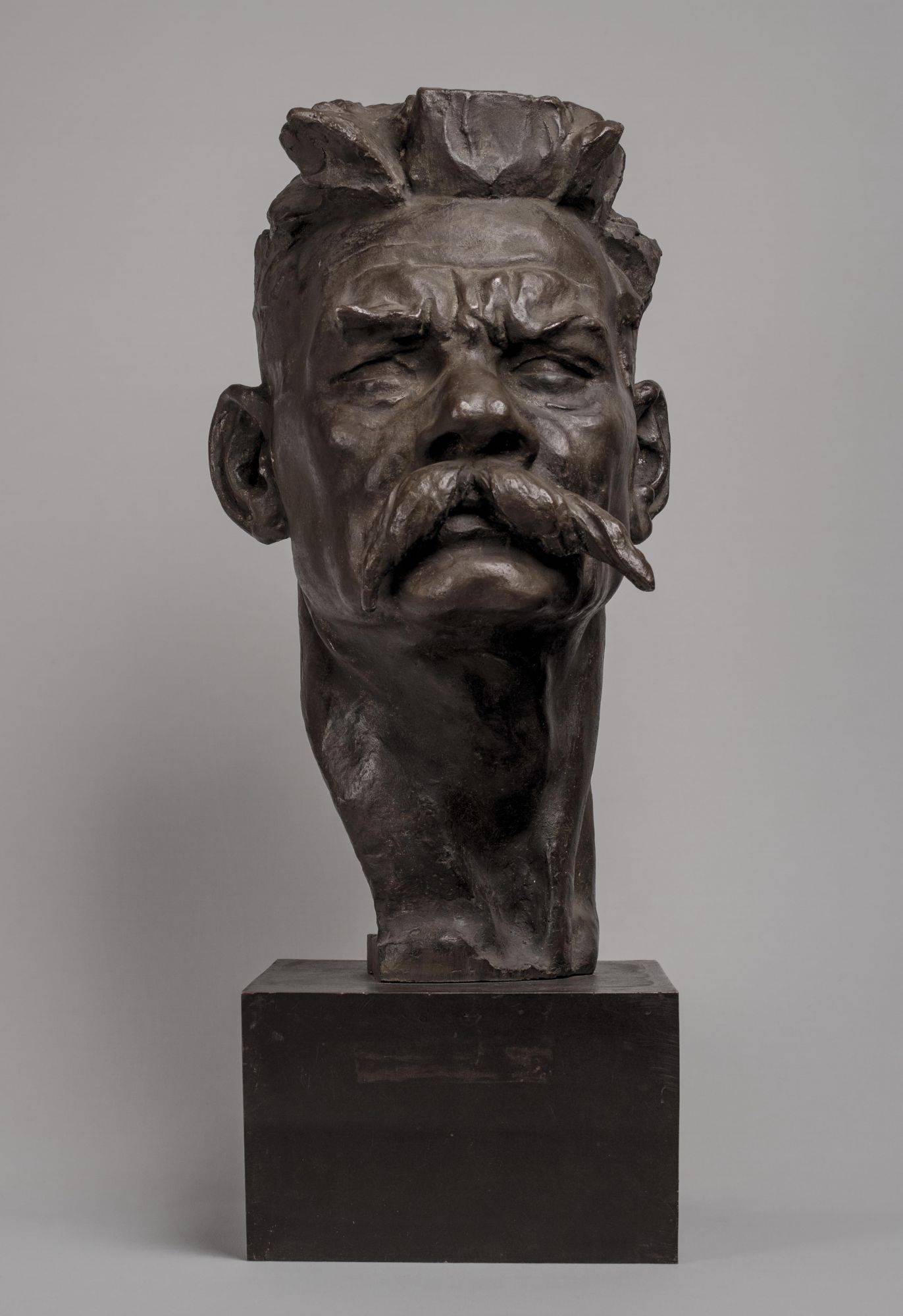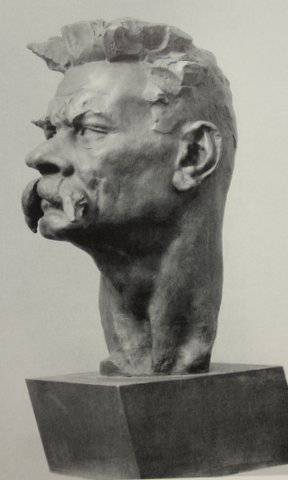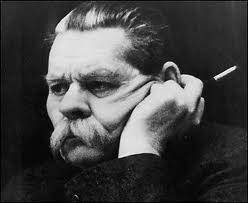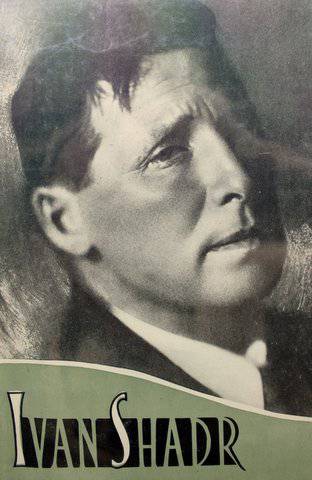Maxim Gorky

Shadr, Ivan Dmitrievich
1887 - 1941
Maxim Gorky
Bronze
66cm (high)
1938
PROVENANCE:
Private collection, Moscow
LITERATURE:
Ivan Shadr, Yuri Koplinsky, Foreign Languages Publishing House, Moscow, Soviet Arts Series, circa 1970, p.81 and illustrated plate 38.
Tretyakov Gallery, Sculpture catalogue, Vol. 2, p. 522, No. 1734, illustrated p. 435.
Certificate Prof. Yermolaev, then head of sculpture at the Tretyakov, dated 17/12/2003.
Certificate Luidmila Victorovna Martz, curator of sculpture at the Tretyakov Gallery, dated 9/4/12.
The cover of Yuri Koplinsky's book on Shadr
This famous head of the Soviet writer Maxim Gorky was made by Ivan Shadr in 1938. The Tretyakov Gallery, at the request of the A.M.Gorky Museum of the Academy of Sciences of the U.S.S.R., Moscow, cast three versions in 1963. The Tretyakov kept one version for themselves, gave one to the A.M.Gorky Museum and our version entered a private collection in Moscow.
Shadr places Gorky on a square stand looking straight back at the viewer. Shadr emphesises Gorky's strong features and fine head of hair but softens the overall effect with his lopsided mustache.

The Treykakov believes this casting was done in 1963 but Yuri Koplinsky in the above mentioned book on Shadr says it was done in 1958. At that date it was hard to get hold of bronze and many scuptures were cast unofficially at the aircraft factory outside of Moscow using whatever alloys they could find.
Shadr was the most emotional and expressive of the leading Soviet Sculptors. He liked to portray his characters with vivid features. Shadr made this head of Gorky and also a large scale full length version known as the Gorky Monument which is now in Moscow in the Square that houses the station for Belorus. Of his sculptures of Gorky Shadr said, "In Gorky's portrait...I present him as we knew him during the last years of his life. This is a calm, clear, extremely simple figure of the great sage...This is a mature genius who has lived a long life, giving all his energy and his talent to his people, to those who he alone could love so well. There is an inner fire and the ability to set the hearts of millions aflame in this old man."
Maksim Gorky, also spelled Maxim Gorki, pseudonym of Aleksey Maksimovich Peshkov(born March 16 [March 28, New Style], 1868, Nizhny Novgorod, Russia—died June 14, 1936). Gorky was one of the most successful writers of the Soviet period who became a friend of Stalin's on his return from exile. He was short-story writer and novelist who first attracted attention with his naturalistic and sympathetic stories of tramps and social outcasts and later wrote other stories, novels, and plays, including his famous The Lower Depths. At his funeral in 1936 Stalin and Molotov carried his coffin.

Maxim Gorky in his final years
Ivan Shadr (Russian: Иван Шадр), pseudonym of Ivan Dmitriyevich Ivanov (Russian: Иван Дмитриевич Иванов) (11 February [O.S. 30 January] 1887, Shadrinsk, now Kurgan Oblast — 3 April 1941, Moscow) was a leading Russian/Soviet sculptor and medalist who took his pseudonym after his hometown of Shadrinsk.
Shadr studied at the Artistic Industrial School in Yekaterinburg from 1903 to 1907, and from 1907 to 1908 at the Drawing School of the Society for the Encouragement of the Arts in St Petersburg where the famous Nicholas Roerich was his teacher. He furthered his education under Auguste Rodin and Emile-Antoine Bourdelle in Paris (1910–1911), and in Rome (1911 – 1912).
Shadr's early works, such as the project for the memorial to World Suffering (1916), were designed according to the principles of Art Nouveau. After the 1917 Revolution he was an active participant in the execution of the Monumental Propaganda Plan, in particular, he sculptured reliefs depicting the Socialist ideological leaders Karl Marx, Karl Liebknecht, and Rosa Luxemburg, as well as some sixteen separate monuments to Vladimir Lenin.
In these years the characteristics of Shadr’s style were consolidated: an elevated, romantic organization of the figures and an emotional, dynamic composition. Among his most famous and characteristic works are sculptures Stone as a weapon of the proletariat (1927) and Woman with an Oar(1936).
In the 1920s, Shadr together with sculptor Piotr Tayozhny came up with one of the first designs of the Order of Lenin, the highest Soviet award. Shadr also worked forGoznak, including on designing new Soviet money that included the symbols of that time: a worker, a peasant and a Red Army soldier. Those sculptures remarkable for their vigorous and dynamic typical characters can be seen nowadays in the Russian Museum (plaster casts) and in the Tretyakov Gallery (bronze sculptures).
Shadr died in wartime Moscow and in 1952 was awarded the Stalin Prize posthumously. He's buried in Novodevichy Cemetery in Moscow, where his sculptural work can also been seen at the grave of Nadezhda Alliluyeva, the second wife of Stalin, and the grave of theater director Vladimir Nemirovich-Danchenko.
- Stone as a weapon of the proletariat, bronze, 1927, multiple versions
- colossal figure of Lenin at the Zemo-Avchaly hydroelectric power station (ZAGES), near Tbilisi, 1927, removed 1991
- Woman with an Oar, multiple versions created 1935 and 1936




